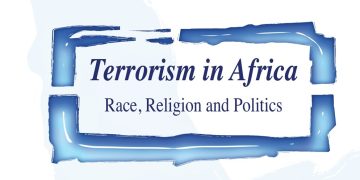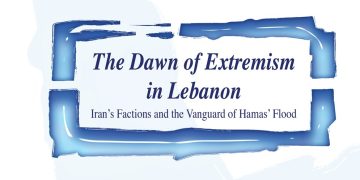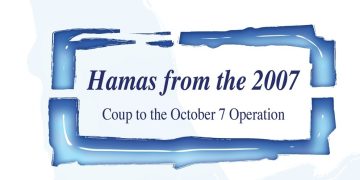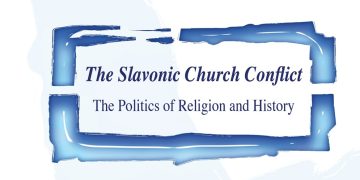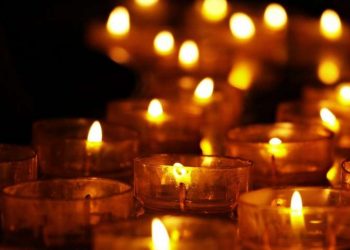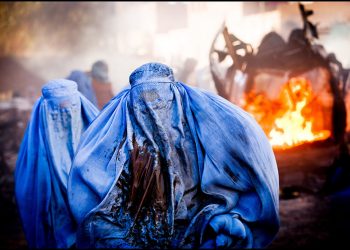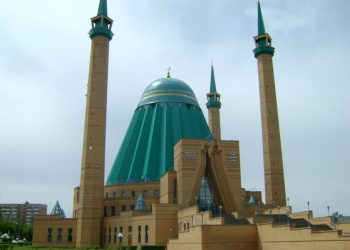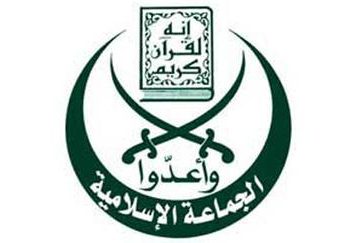by Vivian Fuad
It is not easy to trace relations between Al-Azhar and Egypt’s Coptic Christians — particularly since the revolution of January 25th, 2011, amid its continually shifting consequences. Source materials on the subject are scarce and incomplete. This paper will address Azhari-Coptic relations through a combination of documented meetings and interviews with some of the people who took part in them.
In one such meeting, a group of activists from various political and intellectual currents gathered with the Grand Imam of Al-Azhar, Sheikh Ahmad Al-Tayeb, in March, 2013, to issue a statement about women rights in Islam. The author of this paper was among them: I appealed to the Grand Imam to speedily issue a statement on the subject, which would be Al-Azhar’s first. The case was made that it was high time — following a popular revolution calling for freedom, dignity, and social equality — to discuss Egyptian women’s issues to be discussed in a new light, transcending politicization and an attitude of defensiveness — which on the part of Muslims or Christians. Since the birth of modern day Egypt, both faiths have contributed to a culture in which the issue was instrumentalized to serve the polemics of religion and nationalism. Women became a “text” of sorts — a platform for conflict and political debate — and the cause of empowering them largely suffered as a result. Now was the time to lay the groundwork for a new discourse on women’s issues — and Al-Azhar had the opportunity to lead the way, both for Muslims and for Christians.
Relations in Egypt between Al-Azhar on the other hand and Christian Egyptians (Copts) and the Coptic Orthodox Church on the other tend to improve in a manifestation of national unity when the country is in a state of crisis. The rest of the time, relations amount to little more than formalities during public and national holidays.
The following discussion will be divided into three historical periods in relations between Al-Azhar and Copts in contemporary Egypt. The first begins with the struggle against imperialism in the first half of the twentieth century. The second is marked by heightened unrest between the new faiths since the 1970s. The third begins after the revolution of January the 25th, and is marked by the challenge of establishing a modern democratic state.
1- Standing up to Imperialism
Al-Azhar has been a line of national and cultural defense against imperial powers since the late18th century. From Napoleon’s invasion in 1798 to the British occupation in 1882; Al-Azhar emerged as a center of resistance and support for popular revolt. The image of Coptic Archpriest Sergius (1883-1964) is still fresh in the Egyptian memory: He led a march to the Al-Azhar mosque, ascended the pulpit, and deliver a speech calling for a revolt against the British occupation during the revolution of 1919. The Archpriest suffered imprisonment and exile, as did other political leaders and Al-Azhar scholars. Muhammad Afifi wrote in his book about Archpriest Sergius, “As a Coptic clergyman, [he] regarded his participation in the revolution as a symbol of national unity in Egypt. He was fully aware of the nature of the historical role he played in that time, and instantly knew that his participation alongside Al-Azhar clergymen in national matters would be seen as proof of Egyptian unity — and that their revolution was free of bigotry. He also was aware that the role of Copts in the revolution would contribute to a feeling of unity of the two major sects of Egypt.”
Father Sergius became a model who was followed by other Coptic priests, who also participated alongside Al-Azhar clergymen in the demonstrations of 1919. They, too, delivered speeches in mosques as well as churches. The role father Sergius and others played, and their relations with their Al-Azhar peers, may not have been planned in advance and rather stemmed from a personal gesture by a charismatic figure, Father Sergius. The historical and political context of the conflict with the British made the gesture of Sergius and his fellow priests, as well as the civil and political Coptic elite — in working with Al-Azhar on one hand, and joining the revolutionary movement on the other — an important element in the formation of the 1919 revolution, and establishing a basis for equality of all Egyptians, as called for in the national constitution in 1923. That historic gesture may be regarded as a model for Egyptians to summon amid present-day religious unrest.
2- Religious tension between Muslims and Copts
Since the 1970s, unrest between the two faiths has come in several forms:
a- Violence against Copts and churches perpetrated by radical Islamist groups.
b- Religious debates in which one faith aspired to gain in credence at the expense of the other. Media and the Internet have played a large role in amplifying the impact of the debates, particularly in city
suburbs and slums.
c- Tensions leading to violence, arising from anger at the establishment of a new church, the murder of an adherent to one faith perpetrated by a member of the other, or even a love affair between a Copt and a Muslim.
Several researchers suggest that increasing religious tension since the 1970s has been merely a symptom of the problem of Egyptian national identity in its political, cultural, and social dimensions. It is also an indication that the state has lacked the ability, since independence in 1954, to come up with a new definition of Egyptian nationality as an principle of equal constitutional rights and duties. It may also be related to the failure to to evenly distribute national wealth, and to acknowledge religious and cultural diversity in the country.
Amid the tumultuous political climate of the 1970s and 1980s, inter-religious tensions, and feeble Coptic participation in politics as result of the rise of political Islam, Egypt’s three churches — the Orthodox, the Catholic and the Protestant) took a series of initiatives designed to address problems of Coptic citizenship, as well as religious tensions. The initiatives included the Catholic Coptic Church Justice and Peace Committee, the Orthodox Coptic Church Cultural Development Group, the Coptic Center for Social Studies, and the Cultures Dialogue Forum of the Angelic Coptic Association for Social Services. Though established by the churches, these initiatives were directed and empowered by Coptic youth and not the clergy or political parties — reflecting, in some way, the failure of elected political parties to translate the Copts’ concerns into action.
The initiatives employed several basic tactics: dialogue, media work, and public service. The core themes of the activism included nationality and its problems, respecting cultural and religious differences, Muslim-Coptic coexistence in Egypt, independent religious reasoning in shaping national identity and human rights, women and children’s rights from Christian and Islamic perspectives, and the improvement of religious discourse.
Under political and civic restrictions during the three decades of Mubarak’s rule, discussions in which the Coptic church formally participated were elitist in nature — what has been referred to as a “dialogue of intellectuals,” such as civil activists, journalists, academics, and Coptic and Muslim establishment elites. Al-Azhar was also a participant in these discussions through its scholars, whether by participation in meetings and conferences in Cairo, or Christian clergymen in workshops and training sessions in various Egyptian governorates — all in an attempt to develop a common religious discourse about national identity issues and national unity between Muslims and Copts.
The “Home of the Egyptian Family”: Containment of religious tensions
Inter-religious tensions had reached an unpreceded level on the eve of the the demonstrations of January 25th, 2011 — especially after the tragedy the Saints Church in Alexandria that New Year’s Eve. Twenty-two Copts were killed by a car bomb after Mass. For the first time the Coptic youth marched in the streets rather than staying behind the walls of Orthodox Coptic Church Cathedral, as they had previously done at times of strife. The demonstration of the Coptic youth was a show of anger toward the Mubarak regime. They called for the resignation of the minister of interior — at that, prior to the demonstrations of January 25th, which went on to do the same before calling on Mubarak himself to step down.
Following that tension, the Grand Imam of Al-Azhar, Sheikh Ahmed Al-Tayeb, took the initiative to establish a new foundation: “The Home of the Egyptian Family,” under the patronage of Al-Azhar. Aiming to reduce inter-religious tensions, the foundation included three Egyptian churches as members. Two consultative councils were designated to coordinate between Al-Tayeb and Coptic Pope Shenouda III. They included included Al-Azhar clerics, deputies of the three churches, and lay experts in religious discourse, education, sociology, and civil society. The “Home of the Egyptian Family” is co-directed by the Grand Imam of Al-Azhar and the Coptic Pope. The post-January 25 government went on to issue resolution 1279 in 2011, providing an official veneer to the Foundation and its headquarters at Al-Azhar in Cairo.
The objectives of the “Home of the Egyptian Family” were conveyed as follows:
Consolidate the national identity of all Egyptian citizens.
Reform religious discourse by focusing on values shared by Islam and Christianity.
Spread the discourse through mosques, churches, conferences, and other gatherings.
Pinpoint religious tension triggers, study their causes, and objectively confront them.
Develop strategies and recommendations for government and non-government organizations, particularly in the fields of education, culture, and religious exhortation.
Provide public services in places of religious tension, so as to contain the tension and promote national identity and shared values.
The Home of the Egyptian Family sought to work on fulfilling these objectives through a group of committees:
The Recommendation and Observation Committee;
The Education Committee;
The Family Education Committee;
The Religious Discourse Committee;
The Media and Public affairs Committee;
The Youth and Community Development Committee;
The Urgent Executive Committee;
The Followup Committee and Legal Committee.
For each of these committees there is a rapporteur, an assistant rapporteur, and members chosen according to their specialty.
The “Home” also works on developing religious discourse by organizing training sessions between priests and scholars to discuss the foundation of shared values in both Islam and Christianity, and ways to highlight these values in mosque and church seminars. These meetings are based on enshrining the principle of co-existence: The “Home” would sequester Muslim and Christian clergy in one place for several days, where participants would acquire academic knowledge (through the seminars and the workshops), as well as the experience of living together with each other. Specialists would revise the textbooks of public schools, especially religious textbooks, and remove any hate speech and incendiary content, suggesting alternatives that promote shared values.
Though religious tensions were increasing after January 25th, 2011, the “Home” systematically monitored religiously-driven violence, such as the vandalizing of churches and random murder of Copt citizens. The “Home” sent deputies to these areas to restore the peace, and convened press conferences to issue condemnations. It also raise fund from businesspeople and other citizens to rebuild houses of worship, especially churches that had been pillaged and burnt after the 30th of June revolution in 2013, in which the Muslim Brotherhood was ousted from power. Branches of the “Home” have since been established in several governorates, to expand the experiment in a decentralized manner.
3- Al-Azhar following the revolution of January 25th
The Home of the Egyptian Family was an experiment of an organizational, practical and representational nature for containing religious tension and reforming religious discourse. It was also, as I see it, a post-January 25th experiment by Al-Azhar in issuing intellectual agreeable documents that discuss the future of Egypt and lay down principles for the relationship between Islam and the state. In this respect, it has been essential to the matter of Copts, their national identity, and their relationship with Islam and Muslims.
It was a first for Al-Azhar to take such an action in cooperating with an Egyptian intellectual community of differing political, religious, and intellectual currents; and discussing matters that fall outside the realm of traditional Islamic legal discourse, such as national identity, religious diversity, and popular revolution.
It is fitting, in this context, to review the “Al-Azhar document,” an official statement about the future of Egypt issued in June 2011 which is the result of this unprecedented interaction. We will analyze and discuss the document in the specific framework of its relevance to the concerns of Copts. The document was the result of collaborative efforts by Al-Azhar and a group of Egyptian intellectuals to discuss the nature and future of authority in post-revolutionary Egypt.
A mood of unity and euphoria filled Egyptian streets after the 25th of January revolution. The people of Egypt had finally succeeded in overthrowing Mubarak, who had been in power for about thirty years — during which unemployment rates hit the roof, political and civil freedoms were squelched, and religious tension spiked. The 25th demonstrations in Tahrir Square revived the Egyptians’ historical memory, reminding them of the Egyptian revolution of 1919 and its slogan of national unity: “Religion is for God; the homeland is for all.” During the January uprisings, religion tensions were supplanted by a mood of coexistence, as reflected in photos of Copts encircling Muslims to protect them while preforming prayers and vice versa; Muslim and Christian clergy shaking hands and hugging; and the classic symbol of Egyptian — the crescent and the cross — hoisted in the square. Slogans of protest also called for transcending sectarian and religious identities.
It seemed that Egyptians had finally begun to reclaim a fundamental component of Egyptian nationality — the reintegration of Copts alongside Muslims into the social fabric and civi ethos. This fabric has received several blows since the 1970s. It was as if the struggle against the Mubarak regime had given legitimacy and a new definition to the rights of all Egyptian citizens, which would be enshrined in a new civil constitutional document. The struggle to build on the January 25th revolution would be a political one, rather than sectarian in nature. Alas, politics in Egypt would soon be redivided into their historical dualities: religious vs secular, believer vs unbeliever, Islamic vs liberal, and so on — during the first election after the 25th of January. In a vote over constitutional amendments, one article was struck off, eight were amended, and two were added. Those articles dealt with organizing the presidential and parliamentary elections, and choosing the assembly of the new constitution from among the elected members of the “People’s Council” and “Advisory Council.” The proposal of the constitutional amendments was presented by the High Council of the Armed Forces — the ruler of Egypt at that time — and the legal committee appointed by the council which members have been described as “close –in beliefs and actions- to the Muslim Brotherhood.” Liberal and civil society groups, which together had managed to represent most Coptic citizens, rejected the road map suggested by the High Council of the Armed Forces, which postponed writing the constitution until the people and advisory’s councils were elected. These groups believed that the constitution should precede the election to ensure an equal representation of all political and civil forces that participated in the revolution. At the same time, they didn’t hide their concerns about the advantage Islamist forces had over the moderates on the Egyptian street. There was a concern that choosing the constitutional assembly by the People’s and Advisory Councils, each of which had an Islamist majority, would lead to a sectarian constitution that does not fulfill the needs of the diverse Egyptian population, and contradicts principles of 25th of January revolution. These groups rejected the suggested constitutional amendments, which were to effectively create a religious constitution serving the Muslim Brotherhood. By contrast, Islamist factions (the Muslim Brotherhood and Salafis) naturally agreed to the suggested road map, then to the constitutional amendments which would help them shape the councils and, as a result, dictate the outcome of the constitutional process.
Debates over these matters were couched in binary terms — notably, religious vs civil and secular — in a manner contradicting the spirit and goals of the January 25th revolution. For Islamist forces, voting “Yes” meant yes to Islam, whereas voting “No” meant disbelief and secularism. Hence, discomfort spread through the various factions and classes of Egypt. Concerns grew that Egypt post-January 25 may become an Islamic theocratic state where freedoms are restricted. Among the reasons for the concern: to that concern include:
1- The path political Islam currents took in making their case to the public was a religious one.
2- Assaults on churches continued.
3- Calls by conservatives for changing laws that support women rights to be be consistent with Islamic law — especially those issued during Mubarak’s rule with the support of his wife Susan Mubarak. These calls included canceling the right of women right to seek divorce, criminalizing females circumcision, ending the law restricting women’s marriage to 18 years or older, and amending the children custody law in favor of the father.
4- Going after artists and journalists in freedom of speech lawsuits and punishing their criticism of Islamists.
The new political landscape was, in short, as follows: Political Islam gained power, feeble old parties and the youth movement that drove the demonstrations frittered away, due to their lack of leadership with or an effective political strategy to alter the balance of power on the ground.
Following the issue of the document, Nabil Abdulfattah, one of the participants in the Al-Azhar document, observed a number of factors affecting the nature of the role of the intellectuals as well as the Al-Azhar scholars:
1- The emergence of Salafi challenges and attempts by the Muslim Brotherhood to gain control of Al-Azhar.
2- The failure of the Military Council’s attempts to bring all parties to a state of mutual political understanding. This failure was due to the Council’s effort to come to terms with the Muslim Brotherhood.
3- Concerns of some Copts about suffering from their prior orientation in favor of Mubarak and his regime, and the pro-Mubarak policies of Pope Shenouda the 3rd. A pro-active effort to coordinate with Al-Azhar in general and its Grand Imam as a moderate Islamic scholar in particular.
4- Concerns of some civil, nationalist, and left-wing forces about the rise of political Islamic currents such as The Muslim Brotherhood and the Salafis.
The Coptic concern about Islamists’ risw to power has its justifications. Copts are not a monolith — but the major concern that bring them together are freedom from religious restrictions, and the right to establish new churches and abbeys. The extent to which Copt unite is the cornerstone of Copts’ ongoing presence in Egypt. For the educated middle class, the concern is about discrimination against their political, civil and economic rights, restrictions on their social and cultural life, and their their concerns about personal freedoms essential to their lives — especially in the big cities. As for the inhabitants of slums, where religious tensions are highest and church burnings are the most common, concerns are mainly about personal security. And so it was understandable for Copts to turn to the Grand Imam, who is known for his moderation, tolerance, and orientation toward the Ashari Sufi school of Islamic thought. Meanwhile, the Grand Imam and some fellow Al-Azhar clerics shared the Copts’ concerns about inclusiveness in Egyptian national identity, as well as the identity of Al-Azhar itself as a bulwark against fanatical Salafi currents which, over the past four decades, have made great strides in infiltrating Al-Azhar and its faculty of scholars and preachers.
In the opening statement of a meeting with intellectuals in May 2011 to discuss the “Egypt Future Document,” the Grand Imam expressed his concerns about the future of both Egypt and Al-Azhar: “We are at a crossroads. I wouldn’t say it’s a new situation or a new life, but rather a crossroads. And how unfortunate it is that we face roads full of pitfalls, which may endanger the identity of this country and the moderation that this country has been known for throughout history.”
Muhammad Abdul Fudhail AL-Qausi, a former minister of religious endowments and a participant in the issuing of the document, also expressed his concerns about the Salafi invasion of Al-Azhar. He pointed out that “… [T]he general weakness which has been overrunning Egypt over the last three decades has also overrun Al-Azhar — though the weakness that overran Al-Azhar was not so much a reaction to external factors. In the last three, decades Al-Azhar received several blows, at the top of which was the Salafi ideology. Al-Azhar had stood firmly against that ideology — but the lack of finance on one side, and the crowds working in Saudi Arabia and sending money to support that ideology on the other, made the whole Egypt vulnerable to the virus of Salafi fundamentalism. We found ourselves obliged — we, the professors of Al-Azhar University, or some of us at least — to indulge the ideology until some of us joined that current, and all came back to Al-Azhar as an invasion of Egypt, whereas it was invading the entity of Al-Azhar, which was intellectually fortified, inside out.”
And so participants in the drafting of the document — intellectuals, liberals, leftists, nationalists; women, men; Muslims and Coptsl and Al-Azhar elites — all shared a common concern and a common hope — to change the nature of the political system with respect to political Islamist currents, and to reach a sense of mutual understanding to resolve the problem of religious-civil duality which had existed since the foundation of modern Egypt two hundred years ago.
A read in Al-Azhar Document
Al-Azhar Document reflects an enormous intellectual effort from the participants to establish understandings between Al-Azhar moderate Islamic vision and the humanitarian modern intellect in human rights, nationality and democracy in a desire to put “intellectual frames ruling the community principles and its course” as the document’s body said.
Samir Murqus , one of the participants in the drafting of the document, remarked, “The special thing about this document is that it’s issued by Al-Azhar, and through objective dialogue about several critical issues to reach an intellectual understanding and not a political deal. It’s also an implied acceptance by Al-Azhar and civic intellectuals of the necessity of religious and civic reconciliation. The renewal of religious discourse cannot be completed without the modern intellectual language, the modern intellectual language would also need the legitimacy of Al-Azhar. Accordingly, Copts participated in the document not as a part of the Coptic church, but rather as Egyptian intellectuals.”
The document discusses some of the most important issues concerning the establishment of a modern national constitutional democratic state after January the 25th — such as education, scientific research, social equality, and relations between Egypt and its Arabic, Islamic and African surroundings. It states in the seventh and eighth articles that “[Strengthening] education and scientific research are to be regarded as a responsibility of the government, and Egypt’s entry into the age of knowledge as a prelude to cultural advancement..”; “orienting legislative priorities to achieve social equality and development..”; “building Egypt’s relations with its Arab brethren, Islamic environment, and African environs.. on the basis of cooperating to their common good and advancing the well being of the people within a framework of sovereignty.”
The core articles of the document were the ones addressing the Copts’ concerns in particular, within a broader framework. Those concerns were summed up by articles about the nature of the state, national identity, rejecting discrimination and racism, and the freedom of practicing the three monotheistic faiths — yet delicately phrased as follows:
Article 1: Supporting the establishment of a modern national constitutional democratic state, which functions through a consensual constitution that separates the various powers of the state, defines the ruling system, and ensures the rights and duties of all citizens. The legislative is in the hands of the people’s elected representatives, in accordance with authentic Islamic perspectives. Islam has never known a theocracy that did wrong by its people, and that humanity suffered from in a given era. Islam gave the freedom to people to lead their communities and choose the most suitable mechanism to achieve their wellbeing; with the condition of Islamic law being the basic source of legislation in a manner that ensures that other religions’ followers judging to their own religious laws in personal status suits.
Article 3: Committing to the essential freedoms of belief and speech; respect for women and children rights, and stressing the principle of diversity and respecting divine religions, and considering the national identity is the above-all responsibility in the community.
Article 4: Full respect for diversity and the value of dialogue, the necessity of avoiding the declaration of others to be infidels (“takfir”) and abuse of religion and using it to divide citizens from one another. Considering incendiary, sectarian speeches a crime toward the homeland. The necessity of adopting mutual dialogue and respectful interaction among the various sects of the people of Egypt — without any differentiation, in rights and duties, among citizens.
Article 6: cConcerning the protection of the honor and integrity of, and assuring the full protection of the houses of worship of all three monotheistic faiths. Ensuring the free practice for all religious rites, without any obstacles. Respecting every aspect of worship, without criticizing a sect’s culture or maligning its authentic traditions. Protecting the freedom of speech and artistic creativity in the framework of our cultural values.
In our evaluation, the content and approach of the above articles comes far closer to addressing Copts’ concerns than classical Islamic discourse, which has been based on partial interpretations and excerpts from Qur’anic verses, traditions of the prophet, and historical events to prove that Islam does good by Christians — a selective approach which may be used to prove the opposite as well. The approach followed in the document addresses the Copts’ concerns through principles and rules which are agreed upon by moderate Islamic as well as humanist intellectuals. The document’s approach is also closer to the vision of most Copts of their situation in the Egyptian state as citizens and not as a “minority,” or non-Muslims living in an Islamic state. Coptic citizens care, of course, about their civil, religious and political rights — but they care more about the nature of the state they live in, since they know that their “rights” in the politics of crisis or a sectarian racist state are nothing but a gift from the ruler which he can take back whenever he wants; and that the true assurance for these rights is the struggle alongside the rest of the Egyptians. Hence, these rights are seen as a component of broader national rights in a “modern, constitutional and democratic state” — as the document states — a state with a proactive agenda of cultural and human development and a new renaissance.
Argument between Al-Azhar and the Intellectuals about the “civil state”
The key controversial issue in forming the document was “the nature of the state” and defining the concept of a “civil state” which was proposed by most of the intellectuals as a fundamental component of their contribution to dialogue about the nature of the state.
Nabil Abdulfattah says: “The term ‘civil state’ has no origin or root in political and social sciences. It’s rather an aspect of political and intellectual maneuvering in Egypt and the Arab world, which will lead to more terminology problems rather than consensus at times of division and ideological conflict. It is as if the term ‘civil’ hides the more familiar term — in political and social sciences —‘secular.’
Al-Azhar worries about the terms “civil/secular”
Al-Azhar worries about the development of a “civil” or “secular” state do not amount to a rejection to the concept, or its implementation: Al-Azhar announced more than once during the in the course of preparing the document that moderate Islam accepts the civil-secular concept of constitutional separation between religious establishments and state. The term “civil-secular” has acquired negative connotations among many Muslims who think that the term somehow means a separation of religion from the community of believers, or the remove of religious guidance from the ethos of society — which causes Al-Azhar to be unwilling to use the term. It prefers to use more agreeable terminology that elaborate ib the nature of this “civil state,” — such as “a modern, democratic, constitutional, and nationalist state.”
Intellectuals’ religious and national reference of civil/secular state
Some feel that Egyptian intellectuals’ defense of the notion of a civil-secular state is informed chiefly by Western political and social sciences. But the intellectuals cite their own heritage in defending a civil state: the heritage of enlightened Islamic thought, as well as modern Egyptian trends in favor of a state based on civic, as well as religious, principles.
Both Muslims and Coptic influentials cited the enlightened Islamic heritage of Al-Azhar itself — particularly the late Imam Muhammad Abduh (1905-1949) — to assert that a “civil state” firmly rooted in the country’s heritage. Jabir Usfor — a former culture minister and professor at Cairo University, who participated in the dialogue — quoted Imam Abduh during the various meetings that led to the document. In an article of his, moreover, he wrote, “Imam Muhammad assured [us] that Islam has demolished the foundation of theocracy and removed its trails until there wasn’t any of it. Islam has never given the power to its followers to claim guardianship over it, nor to call the shots on earth … Muhammad Abdah said these words through based on his own independent reasoning, which is still valid, as he saw the five pillars of Islam. [He believed that,] first, reasoning if a tenet of faith; second when jurisprudence and reason contradict each other, reason comes first; third: declaring others to be infidels [takfir] is to be rejected; fourth: [one shoul] take moral lessons from others; and fifth: one should overthrow [pseudo-]theocratic authority and destroying its foundations.”
Salah Fadhl, the author of the draft document, suggested that one of the fundamental principles of the document was to achieve “accordance of Islamic concepts and the idea of civil state.” Samir Murqus added that achieving public civility doest not mean being anti-religious. He also described the model of Imam Muhammad Abduh as a highpoint in Islamic free thinking in Egypt — especially with regard to the nature of political power. He cited the Imam’s pronouncements that there is no religious power in Islam, only the power of good advice; and that a pillar of Islam is overthrowing religious power and destroying its foundations, and the ruler is a civilian in any way.
The body of the document shows how participants repeatedly cited the heritage of reformation, enlightenment, development, and intellectual development among Azhari scholars, beginning with Sheikh Hasan Al-Attar and his student Rifa’a AL-Tahtawi, to Muhammad Abduh and his students Al-Muraghi, Muhammad Abdullah Duraz, Mustafa Abdul Raziq, Shaltoot, and others.
Agreement over the “civil state” in the Egyptian experience
The understandings reached between Al-Azhar and the intellectuals about the nature of the state and the omission of the word “civil” — settling referring instead to a “modern, constitutional, democratic and nationalist [Egyptian] state” — reflects the a pragmatic means to palatably present the notion of a “civil-secular” state in the context of an Egyptian discourse with which both Al-Azhar and the intellectuals were comfortable.
The most important aspects of the agreed-upon “civil-secular” state
1- Rejection of theocracy and calls for separation of powers and a democratic rotation of power.
2- Protecting personal freedoms and lifestyles as a fundamental part of protecting the civility of the state.
3- Religious guidance in society, i.e., the role of religion in Muslim and Coptic living; in the family foundation (marriage, divorce, raising children and inheritance..); and in community relations (male and female roles in society, women’s and children rights, public and personal freedoms..).
4- Accordance between Egyptian legal system and the essentials of Islamic law — meaning that the document, like various constitutions since 1971, is in accordance with the statement, “The whole principles of Islamic legislation are the basic source of legislation.” But the document is also amended to say, “The followers of other monotheistic faiths have the right to judge according to their own jurisprudence in personal status law” — and in so doing, answered one of the Coptic church primary concerns, about the institution of marriage.
5- Supporting the institution of marriage on the respective religious bases of Islam and Coptic Christianity, and restricting inter-religious and inter-doctrinal marriages.
6- Religious freedoms are for the followers of the three monotheistic faiths only — with a social restriction, more than a legal one, on the freedom to change religion or doctrine, which is also supported by the document.
Needless to say, religious freedoms and civil marriage are two essential components of a civil-secular state. Their restriction by religious rules in the Egyptian constitutional model is part of the social and legal contract, which has achieved some balance in the past. A question going forward — in terms of the delicate balance of religious and social mores, especially for the youth — is how to address new demands for personal freedom and non-traditional marriage.
Dr. Vivian Fouad is head of the Coptic Center for Social Studies in Cairo.


